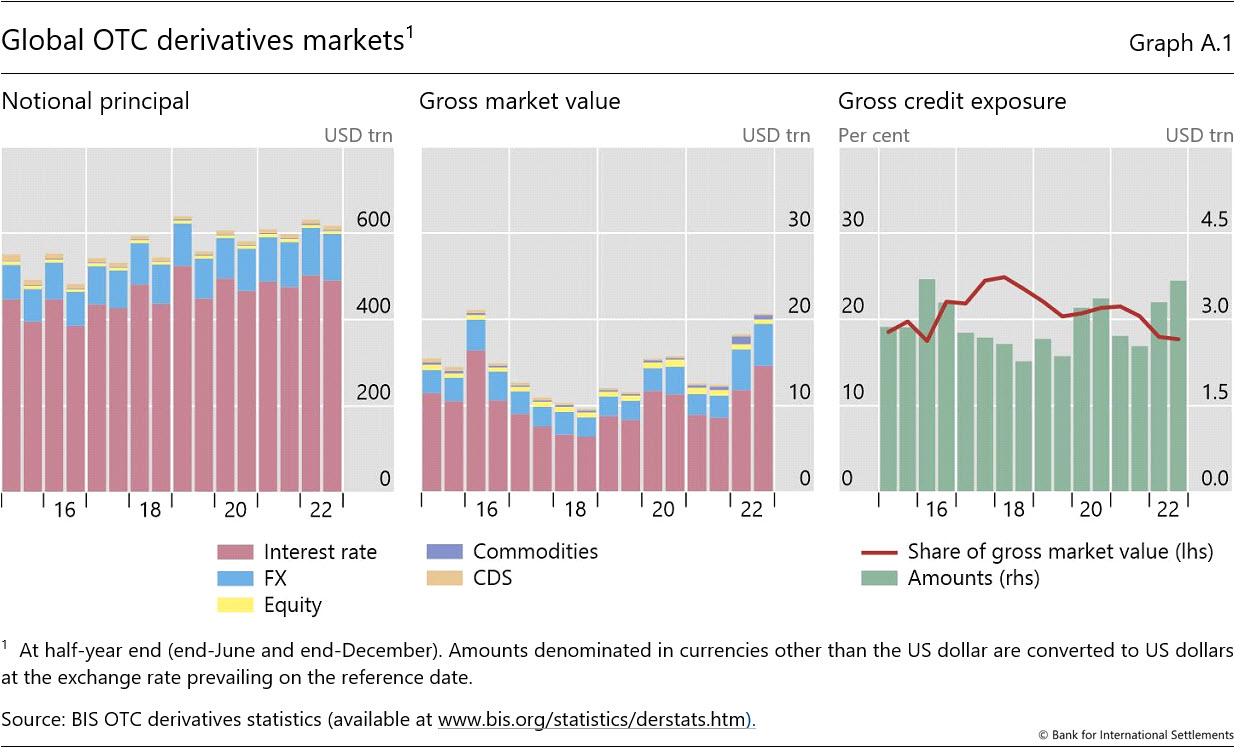OTC derivatives statistics at end-December 2022

Key takeaways
- The gross market value of OTC derivatives, summing contracts with positive and negative values, grew by 13% in the second half of 2022 to reach $20.7 trillion at year-end. Interest rate derivatives drove this increase amid higher inflation and rising rates.
- The gross market value of commodities derivatives fell by 45% in the second half of 2022, reflecting a drop in energy and food prices.
Interest rate derivatives drive rise in gross market values
Derivatives markets in the second half of 2022 evolved in the context of globally higher inflation and policy rate increases. The gross market value of outstanding derivatives – summing positive and negative market values – increased by 13% in the second half of 2022 to reach $20.7 trillion at year-end (Graph 1.A), a level not seen in the preceding six years.1 Similarly, the gross credit exposure measure – which adjusts gross market values for legally enforceable bilateral netting agreements (but not for collateral) – increased by 11% in the second half of 2022 to $3.7 trillion. In contrast, the notional value of derivatives changed little.
Changes in the value of interest rate derivatives (IRDs) continued to contribute most to the overall growth in market values in the second half of 2022 (Annex Graph A.1, centre panel). One key development driving the growth was that central banks, facing higher inflation, raised interest rates for key currencies in 2022.2 As market rates rose above the rates prevailing at the start of IRD contracts, their gross market value increased. Euro-denominated IRDs rose by 23% in the second half of 2022, following a 37% increase in the first half (Graph 2, blue line). Similarly, US dollar IRDs (red line) rose by a respective 40% and 30% in the first and second halves of 2022.
The sharp increases in gross market values contrasted with the stability seen in the notional value of outstanding derivatives. These sagged by only $14 trillion to $618 trillion at end-2022 after a small rebound the previous period, continuing the sawtooth pattern evident since at least 2016 (Graph 1.B). Interest rate derivatives contributed the most to the latest decline (–$12 trillion), while the notional amounts of foreign exchange, equity, credit and other derivatives changed little (see discussion of commodities derivatives below).
Regarding IRDs specifically, the reform of benchmark Libor rates has had a lasting impact on the mix of instruments used. Forward rate agreements (FRAs) denominated in several key currencies affected by the Libor reform (eg GBP, JPY, CHF) have all but disappeared (Graph 3.A).3 For their part, dollar-denominated FRAs (red line), remained just above $10 trillion, down noticeably from 2020.4 By contrast, euro-denominated FRAs, which typically reference Euribor (not phased out), stood at around $30 trillion (Graph 3.A, blue line), similar to their 2020 levels.5
Turning to interest rate swaps (IRS), their notional outstanding amounts also diverged across currencies.6 That for dollar-denominated contracts dropped in the second half of 2022, following consistent increases since end-2020. The 14% decrease in the latest reporting period (Graph 3.B) may indicate that market participants perceived the rate hike cycle to be nearing its end, reducing hedging demand. Yen-denominated contracts actually rose in the second half of 2022, following two consecutive semiannual contractions. The yen's depreciation vis-à-vis the US dollar had contributed to these earlier declines in notional values (when expressed in US dollars).7 By the same token, the increase in the most recent period was supported by the yen's (slight) appreciation in the second half of 2022.
Falling commodity prices cut the value of commodity derivatives
Developments in derivatives on commodities other than precious metals – a category that includes energy, food and other metals – mirrored moves in commodity prices in 2022 (Graph 4.B). Their gross market values surged in in the first half of 2022, but retreated in the second by 45%, to $486 billion at year-end (Graph 4.A, purple line and Annex Graph A.5). Their notional values fell by 24% in the second half of 2022, to $1.5 trillion (Annex Graph A.5).
Annex
1 The quarterly BIS international banking statistics show an even larger increase in the gross market values of derivatives at end-Q3 2022 (not covered in the semiannual OTC derivatives statistics). See BIS international banking statistics and global liquidity indicators at end-December 2022 and Markets swayed by inflation and growth prospects (bis.org).
2 During 2022, the Federal Reserve raised the dollar interest rate seven times, while the ECB raised euro rate four times (See Effective Federal Funds Rate (newyorkfed.org) and Key ECB interest rates (europa.eu)).
3 For more on the transition from Libor to "nearly risk-free" rates, see W Huang and K Todorov, "The post-Libor world: a global view from the BIS derivatives statistics", BIS Quarterly Review, December 2022.
4 Certain US dollar Libor rates will be phased out only at end-June 2023, to support the rundown of legacy contracts.
5 Euribor, or the euro interbank offered rate, is a reference rate constructed from the average interest rate at which euro area banks offer unsecured short-term lending on the interbank market.
6 FRAs reference forward-looking term rates and pay out at the start of an interest period, to mitigate credit risk. Single-period IRS reference backward-looking rates and pay out at the end of a period.
7 The yen's depreciation vis-à-vis the US dollar between December 2020 and June 2022 drove down the reported value (expressed in US dollars) of outstanding yen contracts. Similarly, the yen's appreciation in the second half of 2022 contributed four percentage points to the 20% growth in stocks.












